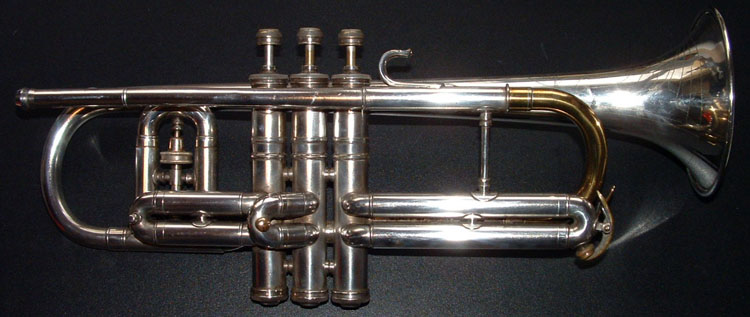

Date: 1946. Owned by Ralph Henssen
Notice the micro-tuning mechanism or "opera glass" just forward of the first valve. This 80A being a later version doesn't have the mechanism that automatically adjusts all slides when the main tuning slide is pulled out to A. The older type 80A also had top spring valves with adjustable spring strength, this version has bottom spring valves. Another minor difference is the fact that on the older model the second slide is at a right angle to the instrument, while on this newer version it angles back towards the player. I am told the 80A has a duo bore or "expanding bore" main tuning slide: the top half is a #2 (0.468") bore, the bottom half is a #2½ (0.484") bore. The lacquered main tuning slide on this otherwise silver plated instrument is not standard, it is a replacement of the original which was damaged. Ralph Henssen tells me it is from a later model 80A.
Models of 80A that were produced during 1953 and 1954 have (I assume nickel-) plated slide ends. For all intents and purposes it looks like someone put a silverplated slide on a lacquered instrument. I suppose you could say these were transitional models leading up the 1955 version of the 80A (see separate entry).
On very rare occasion you will find an 80A with a coprion bell. These will have the serial number engraved on the bell, indicating a U.S. Government instrument. I have seen one in silver plate with a confirmed coprion bell under the silver plating, and one in lacquer. The lacquered one had been relacquered, which might indicate it had originally been silver plated as U.S. Government instruments are almost invariably silver plated. These very few coprion bell 80A's all had serial numbers dating to 1952. As it happens, 1952 was a bumpet year for U.S. Government instruments.
I have learned that the third slide without the finger ring to adjust the pitch of a low D and C# is slightly longer than it is on modern instruments. On modern instruments the low Eb is in tune, but the low D and C# are quite sharp. On these older cornets with the longer third slide no finger ring the Eb is a bit flat and the D and C# are slightly sharp, but not as sharp as they are on later instruments. It was thought that the flat Eb and slightly sharp D and C# were within the abilities of the player to lip into tune.
A member of the Trumpet Herald Forum with experience on the 80A has this to day about using the 80A with various style mouthpieces: "The 80-A's are very mouthpiece sensitive, in that the tonal characteristics change greatly with the mouthpiece choice. If you use a deep cup, such as a Wick or one of the various vintage cornet cups, it gets a very rich, velvety sound to the tone, but loses projection. Put in a fairly deep bowl cup, and the projection gets better, but tone brightens a bit. Put in a Bach C cup of your choice, and you can hang with the trumpets for brightness. Go to a shallow cup and tight backbore, and you can get a laser beam sound."
As far as I can tell at this point, all Conn cornets built before 1958 take a short shank cornet mouthpiece as opposed to the 2¾" "Bach-style" long shank cornet mouthpiece. The long shank cornet mouthpieces won't properly fit a pre-1958 Conn cornet and won't give the proper intonation or playing characteristics of a short shank cornet mouthpiece. All of Conn's "Connstellation" cornet mouthpieces are long shank mouthpieces. The "Improved Precision" Conn mouthpieces such as the Conn 4 are long shank if there is a "ridge" halfway down the shank, and short shank if there is no ridge (in which case it is a "Precision" mouthpiece). All Conn cornet mouthpieces built before the "Improved Precision" series (ridge), such as the "Precision" series (no ridge) are short shank mouthpieces.
What Conn said in 1941:
The 80-A model has made the Victor name famous. It is the favorite of many of the greatest cornet soloists, and a host if the
younger artists have found it to be the ideal cornet for them. Year after year, dozens of the finest school champions in America
win on the Victor. This model has won its popularity on exceptional merit. It is built in large bore and consequently has a big,
mellow, rich tone, but it is so scientifically designed that it reponds with great ease and can be played for long engagements
without tiring the player. Its extremely accurate scale has stood the test of exacting critics for years, and its flexibility
throughout the complete range has never been excelled by any other cornet. Has Clickless Crysteel valves, Victor tuning wheel.
Built in Bb and A.
What Conn said in 1950:
Two generations of fine cornet players have sung the praises of the large bore, Bb-A 80A Victor. Improved year
after year, today it's better than ever.